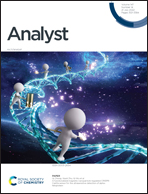Aptamer-based biosensing through the mapping of encoding upconversion nanoparticles for sensitive CEA detection†
Abstract
A sensitive detection system based on aptamer-based biosensors for the detection of carcinoembryonic antigen (CEA) by mapping encoding upconversion nanoparticles (UCNPs) was constructed. In this sensor, oligonucleotides with CEA aptamer fragments immobilized on magnetic beads (MBs) were hybridized to complementary DNA modified on UCNPs (cDNA–UCNPs); thus, sandwich-structured probes were formed. In the presence of CEA, due to the stronger interaction between the aptamer and CEA than that of the aptamer and complementary DNA on UCNPs, the cDNA–UCNPs were isolated from the MBs, and the number of isolated UCNPs was directly related to the concentration of CEA. Using an inverted fluorescence microscope, the number of target-dependent UCNPs on a glass slide was counted, enabling the accurate determination of CEA in the solution. The dynamic range for CEA detection in PBS buffer was 0.02–6.0 ng mL−1 (0.1–30 pM) and a limit of detection (LOD) of 65 fM was achieved. We envisage that the system we developed can also have many promising applications in the sensitive detection of other biomarkers for early cancer diagnosis.



 Please wait while we load your content...
Please wait while we load your content...